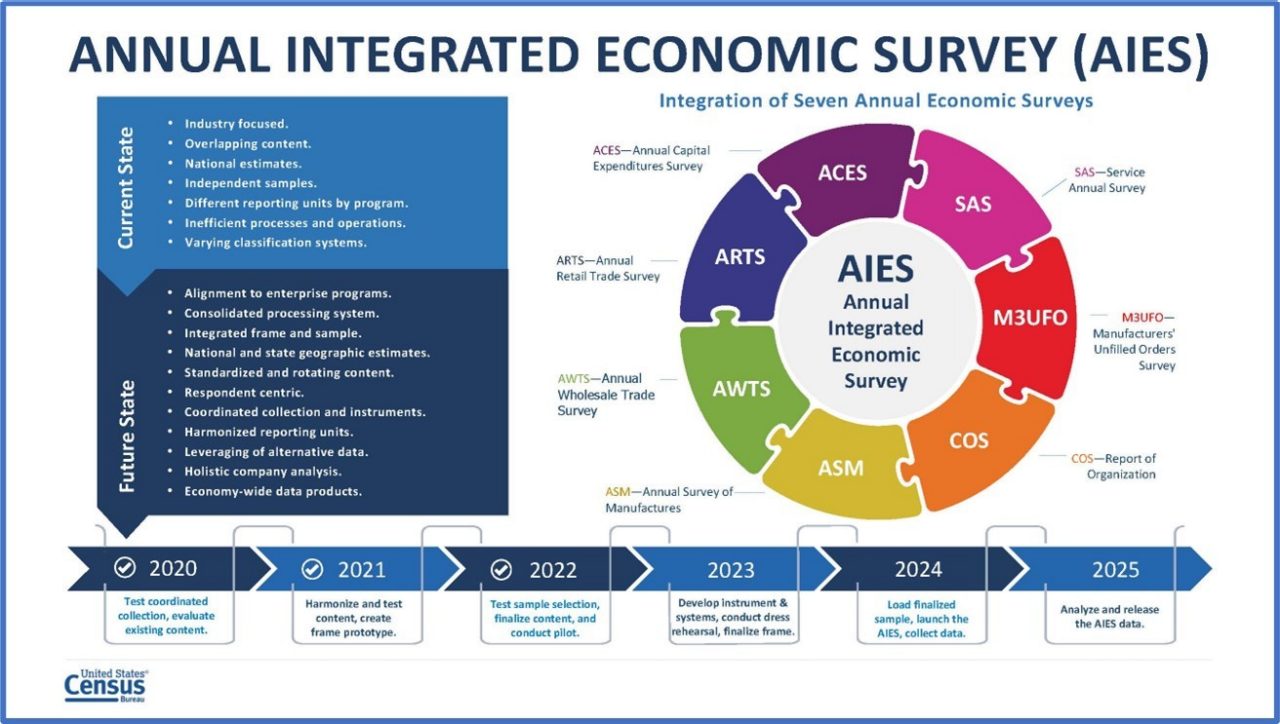Transforming the Census Bureau’s Annual Surveys of Businesses
The U.S. Census Bureau conducts several annual economic surveys of businesses that are critical to the nation’s data infrastructure. These surveys provide a bridge between the comprehensive coverage provided by our 5-year economic census and the timeliness of our monthly indicator surveys. They provide benchmarks for the monthly surveys and help us maintain our Business Register – our frame of U.S. companies and their locations and basic characteristics – that supports all our statistical programs focused on businesses. The annual surveys are a valuable resource used in economic research (including several of my own papers) helping us to understand things like business dynamism and productivity growth.
As part of the Census Bureau’s ongoing commitment to innovation, we are working to reengineer our processes to increase efficiency and improve the data generated by our annual business collections. Efforts began in 2015, when we asked the Committee on National Statistics, known as CNSTAT, of the National Academies of Science, Engineering and Medicine to assemble a panel to review our 11 (at the time) annual economic surveys and make recommendations on how to improve data quality, reduce burden on sampled companies and improve the efficiency and cost-effectiveness of Census Bureau operations. Former Commissioner of Labor Statistics Katharine Abraham chaired the panel that met several times over the 2015-2017 period. Their findings and recommendations are summarized in a 2018 report.
The panel’s key recommendation was for the Census Bureau to design and implement an integrated annual survey system for collecting information from businesses. As a result, and as the culmination of years of work, the Census Bureau is consolidating seven of its annual business surveys into a single survey – the Annual Integrated Economic Survey (AIES). The AIES will replace:
- Annual Retail Trade Survey (ARTS)
- Annual Wholesale Trade Survey (AWTS)
- Service Annual Survey (SAS)
- Annual Survey of Manufactures (ASM)
- Annual Capital Expenditures Survey (ACES)
- Manufacturers’ Unfilled Orders Survey (M3UFO)
- Report of Organization (COS)
This means a more streamlined process that cuts back on the number of requests businesses may receive asking them to participate in surveys. We’ll now collect all the information at one time, eliminating duplicate requests and harmonizing content and reporting units.
In August, the Census Bureau emailed companies across the country to participate in a limited scope collection of our new AIES. This will be followed up by mailings this week. No statistics will be released in this effort. All in all, we’ll be asking approximately 8,300 companies to participate in the final test of the AIES before we put it into full production next year, when it will sample around 385,000 small, medium and large companies.
The figure below provides a visual of the transformation the AIES will accomplish. It shows the seven current surveys transitioning to the AIES, summarizes the current and future state, and provides the timeline of AIES development, testing and production.

Let me highlight a few ways that the AIES improves upon the surveys it replaces.
First, we’ve done extensive respondent outreach and research that informs the AIES strategy and design. By consolidating data collection for multiple sectors into a single platform, we are substantially reducing reporting burden for the many medium- and large-scale companies that operate in more than one sector. We also heard from many respondents that they would like to use spreadsheets to report the more detailed data. Thus, once respondents provide basic company-level characteristics, we generate a customized spreadsheet with the appropriate detailed questions specific to their business. By adding this option, we’ve also aligned the reporting of the AIES with the economic census, which most respondents are already familiar with.
Second, the AIES will leverage key Census Bureau infrastructure investments intended to improve data collection processing and dissemination. AIES will be the first survey to move to our new Data Ingest and Collection for the Enterprise, (known as DICE), platform. This will provide the AIES with dramatically more flexibility adjusting survey content, sampling and introducing nonsurvey source data than feasible in the specialized collection platforms employed by the existing annual surveys. This latter feature is critical as the Census Bureau continues to explore how to use the growing amount of rich source data available from both public and private sources to provide data users with more detailed, timely and accurate economic statistics. We’ve already had some success in augmenting our survey data in the retail trade sector (as with our experimental Monthly State Retail Sales estimates) and in researching methods to more fundamentally reengineer the retail sales and price statistics produced by both the Census Bureau and the Bureau of Labor Statistics. The design of the AIES and the use of these flexible enterprise platforms will allow our statisticians and subject matter experts to efficiently adjust content both generically for all sampled firms or just those in specific industries and geographic areas. By using the Census Bureau’s new infrastructure platforms, the AIES will take advantage of the most up-to-date technology and computing environments to greatly improve the flow of data from collection to dissemination.
Finally, the AIES represents not just a technical transformation but an organizational and cultural one as well. The existing surveys that the AIES will replace, while all managed within the Census Bureau’s Economic Programs Directorate, have evolved independently. They’ve had their own staff, methods and processing systems for decades and developed their own unique ecosystem of data users and stakeholders as well as approaches for working with respondents. Overcoming this inertia was not trivial but our employees and leadership were up to the challenge, knowing that success would position us to provide better data to our users while reducing costs and respondent burden. Moreover, the greater efficiency allows our staff to do what they came to the Census Bureau for – to deliver new and improved data products that track our evolving economy to policymakers, researchers and the public.



